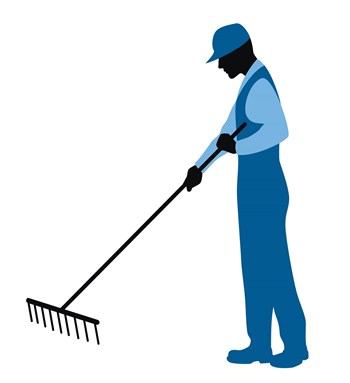
As just about every mother tells her child, it’s important to share with others. The same can be true when it comes to condos and homeowners associations — especially for smaller buildings that may be doing everything they can to control costs. There are a number of different ways that buildings and communities can join forces to share resources — including their employees and staff members — but the goal is always the same: reduce that budgetary bottom line while still maximizing services for residents.
Why Share?
First and foremost, sharing staff members between buildings is a matter of cost. Paying half the salary of a superintendent or maintenance staff member certainly weighs less heavily on a budget than covering the full cost, especially in a small building that may not have need for a full-time employee. Some buildings also ‘bundle’ themselves together as a way to gain bargaining leverage when it comes to bidding out services from contractors and professionals.
“Absolutely, the lowered costs are a benefit,” says Randy Rosen, president of Rosen Management in Chicago. “A couple of our associations have elevators. By having the elevator company handling three buildings literally next door to each other, we’re able to negotiate a discount in fees.”
They are able to do the same thing with other mechanical services as well, because the buildings and their mechanical infrastructures “are generally the same,” Rosen says. “We can leverage services with HVAC companies and can negotiate those discounts, including with preventive maintenance.”
In New York, sharing staff can help meet a housing requirement that mandates that buildings with a certain number of units must have on-site 24-hour janitorial service or arrange to have a staff person available within a certain number of feet of the building. That means one ‘freelance’ superintendent who has proximity to two, three or four buildings may be able to fill that role by virtue of their professional skill as well as their location and ability to get to the site quickly.
How it Works
In most instances, the idea of sharing staff arises when there are already existing commonalities in place between two or three particular condo buildings or associations. “It’s common in an association that has shared common areas or a master association,” says Kara Cermak, president and principal of Rowell Incorporated, AAMC, based in Elgin, Illinois. That means communities that are in close proximity to each other or that exist under a larger, umbrella organization called a master association are the ones that have the most to gain from a shared arrangement.
According to Rosen, “A master association covers other individual associations. These are created when associations are built in phases, so they may be separate associations but they are linked to a master association. That master association might cover the care of recreational facilities, grounds, cleaning or janitorial services, or engineering staff who are maintaining boilers.”
Jeff Stillman, vice president of Stillman Management Inc. in Mamaroneck, New York, also has seen the sharing of staff services take place under the aegis of master associations. With one such arrangement, there were two associations with 120 units each and these associations were separate entities. The third master association oversaw snow removal, landscaping and other duties. The master association shared porters between the two buildings to undertake duties like clearing grounds and providing maintenance. One superintendent also split his time between the two communities.
Stillman says that in his experience, sharing staff between buildings “is really rare,” and happens most often in buildings with a small number of units. “They might share a super if they don’t have someone on-site.” He suggests that arrangements such as these work best if there is one management company overseeing the entire situation. For a successful arrangement, he also suggests finding “an adaptable staff member” to split their duties between the buildings and “boards that get along well.”
In Florida, building staff members are usually employees of the management company, rather than of the building itself, as in New York. According to Doug Weinstein, vice president of AKAM On-Site, based in Dania Beach, Florida, “Down here, we don’t usually share staff, unless that staff member works for the management company and is needed at different properties. Logistically, it gives us the wherewithal to fill in quickly for people if someone calls in sick or leaves unexpectedly. We can move people around as needed.”
The idea for sharing services might also arise as the result of an independent contractor looking to increase their client base. Three or four neighboring buildings might find a way to negotiate a contract for snow removal services, for example, with a lower per-building cost because the contractor does not have to pay for gas to drive from one location to another and can use his crews more efficiently, tackling driveways in rapid succession. These situations can be a win-win for everyone involved and avoids the intricacies of breaking down the duties and timekeeping for a full-time staff person.
Overcoming the Challenges
Sharing staff between buildings and communities has a lot of good things going for it, like saving money, keeping response times down and improving efficiency. As with any project involving multiple parties, however, there are going to be some down sides as well.
“Reporting to multiple supervisors can be difficult, which is why the agreement should be arranged in advance,” says Cermak. “Frankly, there should be one place they are reporting to and that should be through management. It’s important that staff receive the same direction.”
That clear path of supervision can help fend off issues with prioritizing as well, addressing questions such as, if there is a heavy snowstorm, which community or building gets dug out first by the snow removal team.
Another problem area to watch for occurs when the individual providing the service to multiple buildings suddenly encounters difficulties, changes leadership or suffers a sudden decline in quality. “We had a sewer company where there was a change of ownership,” says Rosen. When that change occurred, the company’s level of performance dropped. And when that happened, Rosen says, “We had to replace that person at all three sites” for which they were providing service.
The fair and accurate management of time can be a concern as well, especially if there are two boards and two different management companies involved. If these groups start not getting along, the employee who had been sharing duties between the two buildings or communities will suddenly find himself or herself being pulled in a lot of different directions. Stillman saw that with a superintendent who was trying to meet everyone’s needs in a situation that ultimately generated more questions than solutions. “Who gets whose time? Who’s ordering supplies? Who’s managing the porters’ time?” he says. For years, they tried to find a good balance, but, says Stillman, ultimately the two buildings decided to get their own supers.
These shared situations can result, too, in the individual employee perhaps taking advantage of the arrangement, claiming to be at one site while not being at either. While shenanigans of that kind aren’t typical, “It gives the person an out if they want to take advantage of the situation,” says Stillman.
Giving it a Try
Despite the challenges, and even though the practice of sharing staff may be a relatively limited one, that does not mean it cannot or should not work for those who wish to give it a try.
If one building is looking to perhaps partner with another, Cermak suggests that someone “simply get in touch with the other building’s president or management company. If a community is looking to share staff but they don’t share the same management company or have shared common areas, the agreement needs to be very clear because (staff) may then be reporting to a couple of different people. They would want to have time frames within which they work at one place versus the other.”
Cermak adds, “There should be central management around that sharing. If the community is self-managed, there should be one point of contact that is established up front.”
Everyone seems to agree that overseeing a shared staffing system should ideally be handled by the management company, allowing them to oversee the legal and HR aspects of the arrangement while maintaining fairness across the board. This arrangement also eliminates headaches for volunteer board members or others who are trying to be helpful in juggling sometimes-competing priorities with limited staffing resources.
To avoid major pitfalls among the buildings sharing services, Cernak says, “there just needs to be open communication — how much of their time is being used, and is that time being shared properly so that everyone is paying their fair share for the services.”
Rosen agrees. Sharing staff, he says, “is beneficial to those associations that cooperate with each other.”
For small buildings or for communities that fall under master associations, sharing staff can be a positive for the bottom line as well as for resident satisfaction, meeting needs in an efficient and effective way. All it takes is proper planning, the right staff person with the right attitude and lots of communication. With those elements in hand, there is no reason why this novel approach to staffing cannot be an ongoing success.
Elizabeth Lent is a freelance writer and regular contributor to The Cooperator.






Leave a Comment